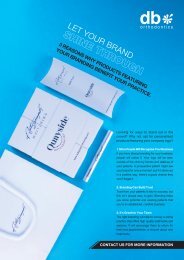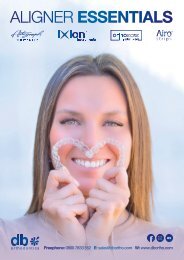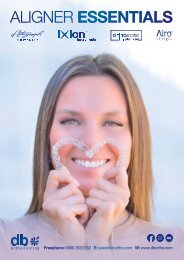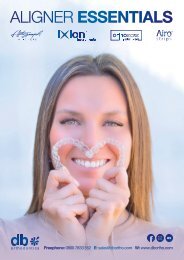Newsletter - December 2021
Create successful ePaper yourself
Turn your PDF publications into a flip-book with our unique Google optimized e-Paper software.
Temporary anchorage devices:<br />
a paradigm shift<br />
SARA HOSNI<br />
Sara is an associate specialist orthodontist at Northenden House Orthodontics and a consultant at Salford<br />
Royal NHS Foundation Trust and Glan Clwyd Hospital. She qualified at the University of Newcastle and<br />
following a variety of hospital posts, Sara undertook her orthodontic specialist training at the University of<br />
Liverpool. In 2015, Sara gained her doctorate of dental sciences degree at Liverpool University.<br />
Although temporary anchorage devices (TADs) have<br />
been available for clinical use for at least a couple of<br />
decades now, it’s fair to say that they are not yet<br />
being utilised to their full potential. We are well<br />
versed in the theoretical workings of TADs or, more<br />
specifically, miniscrews, but how often are we using<br />
them as realistic alternatives in otherwise complex<br />
cases?<br />
Every now and then, a case comes along<br />
that challenges our well-rehearsed rhythm of the<br />
usual treatment mechanics and acts as a paradigm<br />
shift in how we practise clinical orthodontics. So,<br />
what exactly are TADs, and why are more and more<br />
people raving about them?<br />
Temporary Anchorage Devices<br />
TADs are used for skeletal anchorage and are<br />
inserted into the bone to enhance orthodontic<br />
anchorage (Chen et al, 2006), either by supporting<br />
the anchor teeth (indirect anchorage) or by acting<br />
as anchor units in their own right (direct anchorage),<br />
eliminating the need for supporting teeth (Mizrahi<br />
and Mizrahi, 2007). They are removed once their<br />
function has been completed. They have many<br />
advantages, which have been summarised in Table<br />
1. The risks associated with TADs are well documented<br />
(Table 2); however, with appropriate training<br />
and diligence in case planning, most of these can be<br />
avoided.<br />
There are several indications and<br />
contraindications for the use of TADs, which are<br />
summarised in Table 3, as good case selection is<br />
key to achieving the intended outcome in a<br />
predictable manner. Impressive success rates for<br />
TADs, ranging from 76% to 96%, have been reported<br />
in the literature (Bearn and Alharbi, 2015; Son<br />
et al, 2014). It has been shown that success rates<br />
are directly correlated with various factors, including<br />
age, site of placement and miniscrew diameter (Lee<br />
et al, 2010).<br />
Case Study<br />
Figures 1 to 11 demonstrate a case where Infinitas<br />
TADs were used to provide both direct and indirect<br />
anchorage for the treatment of an anterior open bite<br />
and class 2 malocclusion.<br />
The alternative treatment option was a<br />
combination of orthodontics and orthognathic<br />
surgery, which the patient was not keen on. The<br />
plan was for the TADs to be placed palatally and<br />
‘locked’ to the transpalatal arch in order to provide<br />
indirect anchorage for correction of the buccal<br />
segment relationship after extraction of the upper<br />
first premolars. They would then be used for direct<br />
anchorage for the intrusion of the upper buccal<br />
segments, thereby correcting the anterior open bite.<br />
The patient was compliant, the TADs<br />
survived the treatment duration, and in the end, we<br />
had one delighted patient who didn’t need<br />
orthognathic surgery. So, should we be offering this<br />
to all anterior open bite patients? Case selection is<br />
fundamental to achieving a successful outcome, so<br />
undoubtedly, there will always be cases that will still<br />
require a surgical approach. However, for a<br />
number of patients, the use of TADs can mean<br />
avoiding orthognathic surgery and the risks that<br />
come with it.<br />
Being critical of the finish, despite<br />
undertaking lower arch extractions,the patient still<br />
had some gingival recession of the lower left central<br />
incisor. A gingival graft was discussed to address<br />
the recession of the lower left central incisor.<br />
Summary<br />
In summary, TADs provide an alternative to<br />
conventional mechanics for anchorage control, and<br />
there is increasing interest in their use. Outcomes<br />
that would otherwise require orthognathic surgery or<br />
would not be possible may be achieved using TADs<br />
in combination with orthodontics.<br />
E: sales@dbortho.com www.dbortho.com
















